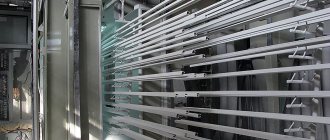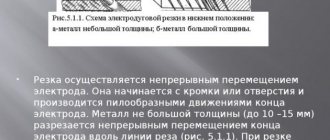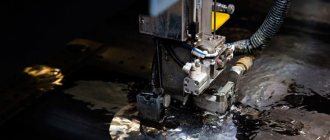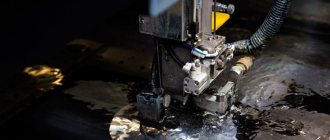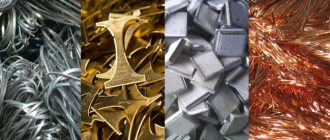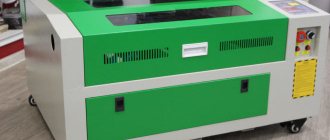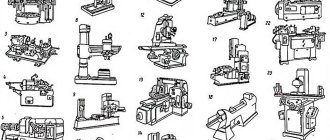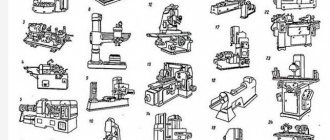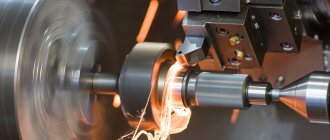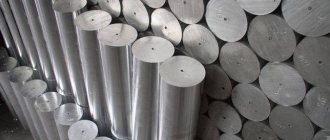General principles
The essence of this technology is to transform the outer layer of the material by saturation. Chemical-thermal processing of metals and alloys is carried out by keeping the materials being processed in environments of a specific composition of different phase states during heating. That is, it is a combination of plastic deformation and temperature effects.
This leads to a change in the parameters of the steel, which is the purpose of chemical-thermal treatment. Thus, the purpose of this technology is to improve hardness, wear resistance, and corrosion resistance. Compared to other technologies, chemical-thermal treatment differs favorably in that with a significant increase in strength, ductility does not decrease so much. Its main parameters are temperature and holding time.
The process under consideration includes three stages:
- dissociation;
- adsorption;
- diffusion.
The intensity of diffusion increases if interstitial solutions are formed and decreases if substitution solutions are formed instead.
The amount of a saturating element is determined by the influx of its atoms and the rate of diffusion.
The size of the diffusion layer is affected by temperature and exposure time. These parameters are directly related. That is, with an increase in the concentration of the saturating element, the thickness of the layer increases, and an increase in the intensity of the thermal effect leads to an acceleration of diffusion, therefore, over the same period of time it will spread to a greater depth.
The solubility of the saturating element in the material of the workpiece is of great importance for the diffusion process. In this case, boundary layers play a role. This is explained by the fact that, due to the presence of many crystalline defects at the grain boundaries, diffusion occurs more intensely. This is especially evident in the case of low solubility of the saturating element in the material. With good solubility this is less noticeable. In addition, diffusion accelerates during phase transformations.
Materials for chemical processing of metal alloys and joining metal parts of prostheses
All topics in this section:
Acceptable abbreviations GOU VPO UGMA - State Educational Institution of Higher Professional Education Ural State Medical Academy GIC - glass ionomer cement SOPR -
Temporary filling materials Temporary filling materials, or dressings, are used for short-term closure of the treated carious cavity (if it is impossible to complete treatment in one session) for a period from 1 to 14 days. Vre
Aqueous (artificial) dentin Composition: - powder - zinc oxide - 66%, - zinc sulfate - 24%, - kaolin -10%. - Mixing liquid - distilled water. Zinc sulfate
Dentine paste Ingredients: artificial dentin powder mixed with clove or peach oil. Available in a bottle. No need to knead. The paste is brought into the cavity, condensation
Vinoxol Composition: - powder - zinc oxide, - liquid - polystyrene in guaiacol. Method of preparation The mass of paste-like consistency is ready
Zinc oxide eugenol cements Composition: - powder - zinc oxide, zinc acetate, acetic anhydride, rosin (1-2%) (hardening acceleration). — Liquid — eugenol or clove oil, ethyl spirit
Polycarboxylate cements Composition: - powder - thermochemically treated zinc oxide, magnesium oxide (reducing the reactivity of the mixture); — liquid — an aqueous solution of polyacrylic acid.
Light-curing materials for temporary filling Prepared in the form of a paste. Added in 1 portion, cured with the light of a halogen lamp for 20-40 s. Representatives: — “CimpatLC” (Septodont), — “Clip”
Materials for isolating pads Isolating pad is a layer between the permanent filling and the bottom of the carious cavity (therapeutic pad) within the enamel-dentin border, protecting dentin and pulp from harmful influences,
Zinc phosphate cements Composition: - powder - zinc oxide, - additives of magnesium oxide, silicon dioxide, bismuth trioxide. — Liquid — aqueous solution of phosphoric acid, — additives
GIC A) Classification of GIC according to the hardening mechanism: 1. classical (traditional) two-component GIC; 2. hybrid GIC double (triple) curing; 3. single-component
Insulating varnishes are used to create a thin-layer (liner) gasket. They are a one-component system. Composition: 1. polymer resin (copal resin, rosin
Materials for therapeutic pads A therapeutic pad is a part of the filling placed on the bottom of the cavity for a therapeutic effect on the pulp. Requirements: 1.anti-inflammatory, antimicrobial
Calcium hydroxide preparations Advantages: 1. anti-inflammatory, antiseptic effect; 2. stimulation of the formation of replacement dentin. Disadvantages: 1.
Zincoxide-eugenol preparations (For composition and preparation methods, see paragraph “Temporary filling materials”). When used as a therapeutic pad, they are used to relieve inflammation.
Combined medicinal pastes Include several groups of medicinal substances and are prepared extempore, taking into account the clinical situation, compatibility, availability in the medical institution and the individual preferences of the doctor. Basics
Varnishes containing odontotropic substances Contrasil is a self-hardening varnish based on calcium hydroxide and zinc oxide. Apply with a brush to the bottom of the cavity, firmly connects, and when dry, forms a thin, smooth layer. Used for
Cements Cements are powdery mixtures that are mixed with water or aqueous solvents. As a result of kneading, a plastic mass is formed, which then hardens. At the same time not
Polycarboxylate cements Represent a “powder-liquid” system. Composition: - powder - zinc oxide with the addition of magnesium oxide, - liquid - 37% solution of polyacrylic acids
Amalgams Silver amalgam is an alloy consisting of silver powder (66%), tin (29-32%), copper (2-6%), zinc (1%) and liquid (mercury). The main thing during curing is inter
Unfilled polymer filling materials have been used for filling teeth since 1939. They were fast-hardening plastics of cold polymerization and were made on the basis of acrylic and epoxy resins.
Composite filling materials Composite materials are materials consisting, according to the international ISO standard, of 3 components: 1. organic matrix based on copolymers of acrylic and epoxy resins.
Adhesive (bonding) systems Adhesive systems are a set of complex liquids that promote micro-retentive attachment of composites to enamel and dentin tissues. They include 3 components:
Ormokers Conventional composites are based only on an organic resin matrix. In contrast, ormoker consists of an inorganic-organic network structure formed during the process of polycondensation
Compomers Compomers (glaciosites) are restoration materials that are composite ionomer compositions. Compomers combine the properties of composites (ease of use, aesthetically pleasing
Filling materials for root canals Filling (obturation) of the root canal is one of the most important stages of endodontic treatment. — On the one hand, this operation provides reliable isolation of periodontal tissues from
Plastic non-hardening materials Plastic non-hardening materials are used for temporary filling of root canals. They are absorbed in the root canal and therefore do not provide long-term obturation. 1) Pastes on
Plastic hardening materials 1) Zinc phosphate cements (Uniface) Not used now. Advantages: 1.radiographic contrast; 2.just enter
Primary hard materials Primary hard materials are fillers. They are used only in combination with plastic hardening pastes (sealers) and serve to fill the lumen of the root canal and increase reliability
Antiseptic liquids for washing root canals Requirements: 1. bactericidal effect; 2. harmless to periodontium; 3. fast and deep penetration into the dentinal tubules; 4. chemical
Materials used in orthopedic dentistry Materials used in dentistry are divided into basic and auxiliary. Basic materials are those materials from which dentures, appliances and fillings are made.
Metals and Alloys Alloy is a substance obtained by fusing two or more elements. Metal alloys are macroscopically homogeneous systems consisting of two or more metals with
Refractory metal alloys A) noble (up to 1100 degrees) - alloys of gold and silver. Assay system for gold Assay is an expression of the dignity or value of an alloy
Gold alloys Pure gold is a soft metal. To increase elasticity and hardness, so-called alloy metals are added to its composition - copper, silver, platinum. Gold alloys differ in the percentage of its soda
B) base 1) stainless steels Steel is an alloy of iron and carbon, which, as a result of primary crystallization, acquires a single-phase structure. Steel m
Cobalt-chrome and nickel-chrome alloys Cobalt-chrome alloys of the KHS brand. Composition: - cobalt 66-67%, which gives the alloy hardness, thus improving the mechanical qualities of the alloy. - chro
Dental porcelain and glass ceramics Porcelain is a ceramic product obtained by firing porcelain mass prepared from the main components - kaolin, feldspar, quartz and dyes. Far
Plastics Plastic is a material that, to a certain extent, has plasticity (the ability to perceive and retain deformation). Classification of plastics in relation to temperatures
Preparation of plastic dough Requirements for plastic dough: 1. maximum density; 2.exact ratio of components (monomer:polymer = 1:3); 3.full maturation of the dough; 4.temper
Cold-curing plastics If in hot-curing plastics external heat is the initiator of the polymerization reaction acting on the catalyst, then in cold-curing plastics the initiator is a special
Impression materials An impression is a negative image of the surface of hard and soft tissues located on the prosthetic bed and its boundaries, obtained using special materials. Model
Crystallizing impression masses Physical properties Natural gypsum is a widespread mineral of white, gray or yellowish color. The formation of gypsum occurs as a result of its loss in
Thermoplastic masses have a distinctive feature - they soften and harden only at a certain temperature. Classification of thermoplastic masses: - reversible, - irreversible. &
Elastic impression materials 1. alginate, 2. silicone (polysiloxanes), 3. polysulfide (thiokol), 4. polyester. Alginate masses Alginates are
Polyester impression materials The polyester contained in the base paste is a non-standard copolymer of ethylene oxide and butylene oxide units. The ends of this macromolecular chain are converted into reactive rings
Low-melting alloys Composition: - bismuth, - lead, - tin, - cadmium. Application: material for dies and models in the manufacture of crowns and crowns
Molding materials The technological stage preceding the casting of metal alloys is molding. Molding is the process of making a mold for casting metals, and the molding compound serves the mother
Gypsum molding materials Composition: - gypsum (20-40%), - silicon oxide. In this case, gypsum is the binder. Silicon oxide, acting as a filler, gives the mass the necessary amount of mustache
Phosphate molding materials Composition: - powder (zinc phosphate cement, ground quartz, cristobalite, magnesium oxide, aluminum oxide hydrate, etc.); - liquids (phosphoric acid, magnesium oxide, water, hydrate
Silicate molding materials have almost universally been replaced by phosphate materials. They are characterized by high heat resistance and strength. Their introduction is caused by the use of CHS and stainless steels. Compound:
Abrasive materials Various orthopedic devices, including dental, jaw and facial prosthetics, require careful finishing to give them a smooth, polished, shiny surface. Purposes used
Polishing agents Polishing is the processing of products to obtain a smooth mirror surface (grade 12-14). Polishing methods: 1. mechanical (processing with an abrasive tool,
Insulating and covering materials Reasons for the need to use insulating materials: 1. Penetration of water vapor from gypsum into plastic during its polymerization in a water bath leads to the appearance of lesions on
Classification
Chemical-thermal treatment of steel is divided based on the phase state of the saturation medium into liquid, solid, and gas.
In the first case, diffusion occurs on fragments of contact between the surface of an object and the environment. Due to its low efficiency, this method is not widely used. The solid phase is usually used to create liquid or gaseous media.
A chemical-thermal operation in a liquid involves placing an object in a molten salt or metal.
In the gas method, the saturation element is formed by the reactions of dissociation, disproportionation, exchange, and reduction. Most often in industry, heating of solids is used to create gaseous and active gaseous media. It is most convenient to carry out work in a purely gaseous environment due to rapid heating, easy adjustment of the composition, no need for reheating, and the possibility of automation and mechanization.
As you can see, classification based on the phase of the medium does not always reflect the essence of the process, so a classification was created based on the phase of the saturation source. In accordance with it, chemical-thermal treatment of steel is divided into saturation from solid, steam, liquid, and gas media.
In addition, chemical-thermal technology is divided according to the type of change in the composition of steel into saturation with non-metals, metals, and removal of elements.
According to the temperature regime, it is classified into high and low temperature. In the second case, heating is carried out to the austenitic state, and in the first case, it is heated higher and ends with tempering.
Finally, chemical-thermal treatment of parts includes the following methods, distinguished on the basis of execution technology: carburization, nitriding, metallization, nitrocarburization.
Diffusion metallization
This is the surface saturation of steel with metals.
Can be carried out in liquid, solid, gas media. The solid method involves the use of ferroalloy powders. The liquid medium is a molten metal (aluminum, zinc, etc.). The gas method involves the use of metal chloride compounds.
Metallization
Metallization produces a thin layer. This is explained by the low intensity of diffusion of metals in comparison with nitrogen and carbon, since instead of interstitial solutions they form substitution solutions.
This chemical-thermal operation is performed at 900 - 1200°C. This is an expensive and lengthy process.
The main positive quality is the heat resistance of the products. In view of this, metallization is used to produce items for operating temperatures of 1000 - 1200 ° C from carbon steels.
Based on the saturating elements, metallization is divided into aluminizing (with aluminum), chromium plating, boriding, and sicylation (silicon).
The first chemical-thermal technology makes the material resistant to corrosion scale, but aluminum remains on the surface. Aluminizing is possible in powder mixtures or in a melt at a lower temperature. The second method is faster, cheaper and simpler.
Chrome plating also increases resistance to corrosion and scale, as well as to acids, etc. For high and medium carbon steels, it also improves wear resistance and hardness. This chemical-thermal operation is mainly carried out in powder mixtures, sometimes in a vacuum.
The main purpose of boriding is to improve resistance to abrasive wear. Electrolysis technology using molten boron-containing salts is widespread. There is also an electrolysis-free method that involves the use of chloride salts with ferroboron or boron carbide.
Sicylation increases resistance to corrosion in salt water and acids, wear and scale of some metals.
Process stages
The whole process is divided into three stages, which follow each other:
- Dissociation is the process of disintegration of molecules of a substance with the formation of active atoms that move to the surface being treated.
- Adsorption is the connection of active atoms with the surface being treated and penetration and adhesion occurs. Physical and chemical interaction of elements occurs.
- Diffusion is the process of penetration of active atoms of a substance into the atomic lattice of the metal being processed at high temperatures. The higher the heating degree, the deeper the penetration of substances into the products. The structure of the surface of metal products changes, giving them the desired properties.
Another chemical-thermal treatment
Metals are divided into three types, depending on the state of the environment in which the process occurs: gas, liquid and solid. With the gas method, rapid heating occurs, it is easy to control the reaction, and use automation and mechanization. Liquid is less common than gas, and solid is used mainly to obtain a liquid or gaseous medium.
We briefly reviewed the technology of chemical-thermal treatment in Moscow
metal products, which is a high-tech production process that raises product quality to a new level.
Carburization (cementation)
This is the saturation of the surface of steel objects with carbon. This operation improves the hardness, wear resistance, and endurance of the material surface. The underlying layers remain viscous.
This chemical-thermal technology is suitable for items made of low carbon steel (0.25%) subject to contact wear and variable loads.
Mechanical processing is required first. Non-cemented areas are covered with a layer of copper or coatings.
The temperature regime is determined by the carbon content in the steel. The lower it is, the higher the temperature. For carbon adsorption and diffusion, in any case, it should be 900 - 950 ° C and higher.
Steel Cementation
Thus, by saturating the surface of steel parts with carbon, a concentration of this element in the upper layer of 0.8 - 1% is achieved. Larger values lead to increased brittleness.
Cementation is carried out in a medium called carburizer. Based on its phase, the technology is divided into gas, vacuum, pastes, solids, and ionic.
The first method uses coal semi-coke, charcoal, and peat coke. To speed things up, activators are used and the temperature is increased. Upon completion, the material is normalized. Due to the duration and low productivity, this chemical-thermal technology is used in small-scale production.
The second technology involves the use of suspensions, coatings or slips.
The gas environment is most often used in carburization due to speed, simplicity, the possibility of automation, mechanization and the achievement of a specific carbon concentration. In this case, methane, benzene or kerosene are used.
A more advanced method is vacuum cementation. This is a two-step process under reduced pressure. It differs from other methods in speed, uniformity and light layer surface, absence of internal oxidation, better production conditions, and equipment mobility.
The ion method involves cathode sputtering.
Cementation is an intermediate chemical-thermal operation. Next, hardening and tempering are carried out, which determine the properties of the material, such as wear resistance, endurance during contact and bending, and hardness. The main disadvantage is the duration.
Nitriding
This term refers to the saturation of the material with nitrogen. This process is carried out in ammonia at 480 - 650°C.
With alloying agents, this element forms nitrides, characterized by dispersion, temperature stability and hardness.
This chemical-thermal treatment technology increases hardness, resistance to corrosion and wear.
Preliminary mechanical and thermal treatment is required to achieve final dimensions. Non-nitrided fragments are coated with tin or liquid glass.
Typically a temperature range from 500 to 520°C is used. This gives a 0.5 mm layer in 24 - 90 hours. Thickness is determined by duration, material composition, temperature.
Nitriding
Nitriding leads to an increase in the number of processed parts due to an increase in the volume of the top layer. The amount of growth is directly determined by its thickness and temperature conditions.
In the liquid method, cyanide-containing, less often cyanite-free and neutral salts are used. Ionic chemical-thermal operation is characterized by increased speed.
Nitriding is divided according to its target properties: it achieves either improved corrosion resistance or increased wear resistance and hardness.
Etching and bluing
Chemical treatment of metal can be carried out for decorative purposes, which has long been used by craftsmen. Products made of steel, copper, brass, and silver are decorated in this way.
Metal etching is the removal of the surface layer from workpieces using etchants. Since the area of influence of etchants can be controlled by applying a non-reactive film, the result can be raised artistic images and patterns in which the elements will differ in color. Reagents remove only the surface layer of the material, however, excessively long exposure can damage the closed parts, which will ruin the design.
Using etching, they decorate knife blades, create jewelry and decorative items from brass, copper, and bronze. It also cleans metal products from dirt, grease and oxides.
Blueing involves applying a protective layer to the surface of metal products - this layer consists of iron oxides, and the final color of the tarnish depends on its thickness. Blueing protects steel from corrosion and is a method of decorative finishing of metal.
Both etching and bluing can be done at home and without special skills, but the potential danger of the reagents should be taken into account. Wear eye, respiratory and hand protection, work only in well-ventilated areas, and properly dispose of waste materials.
Cyanidation, nitrocarburization
This is a technology for saturating steel with nitrogen and carbon. In this way, steels with a carbon amount of 0.3 - 0.4% are processed.
The ratio between carbon and nitrogen is determined by temperature. As it grows, the share of carbon increases. If oversaturated with both elements, the layer becomes brittle.
The layer size is affected by exposure time and temperature.
Cyanidation is carried out in liquid and gaseous media. The first method is also called nitrocarburization. In addition, according to the temperature regime, both types are divided into high and low temperature.
In the liquid method, salts with sodium cyanide are used. The main disadvantage is their toxicity. The high-temperature version differs from carburization in speed, greater wear resistance and hardness, and less deformation of the material. Nitrocarburization is cheaper and safer.
Nitrocarburization of steel
The final mechanical treatment is first carried out, and the fragments that are not subject to cyanidation are covered with a layer of copper 18 - 25 microns thick.
